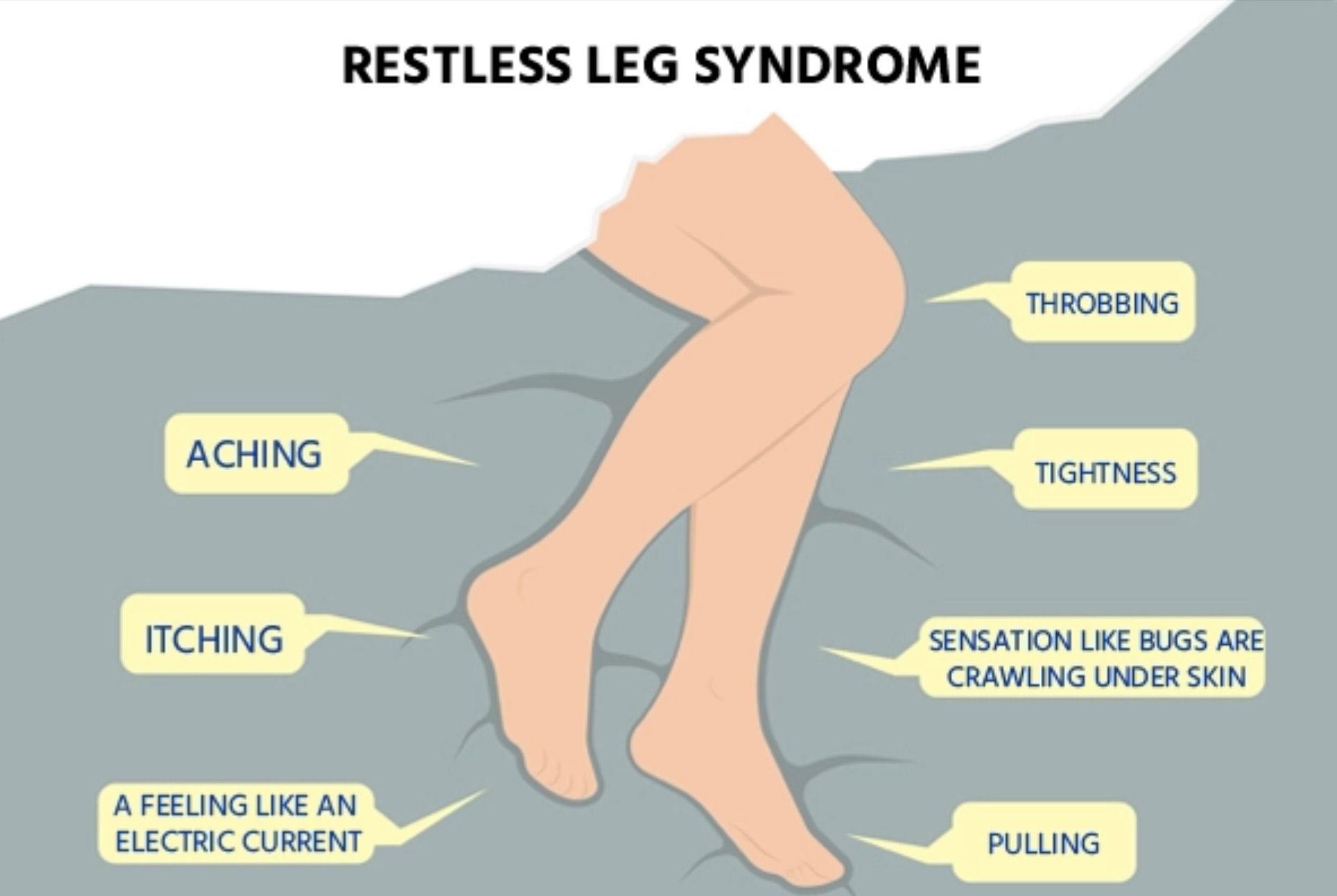Restless Legs Syndrome (RLS): Symptoms, Causes, Treatment
What are the symptoms of restless legs syndrome?
Restless legs syndrome (RLS) is a neurological disorder characterized by an uncontrollable urge to move the legs, usually due to uncomfortable sensations in the legs. Symptoms of restless legs syndrome may include:
- Urge to Move Legs: People with RLS often have an overwhelming urge to move their legs, especially when resting or lying down. This urge is often accompanied by uncomfortable sensations in the legs.
- Uncomfortable Sensations: Individuals with RLS may describe the sensations in their legs as crawling, creeping, itching, pulling, tingling, or burning. These sensations are often difficult to describe but are typically relieved by moving the legs.
- Symptoms at Rest: The symptoms of RLS are usually most pronounced at rest, especially in the evening or at night when lying down. This can lead to difficulty falling asleep or staying asleep, which can result in daytime fatigue and sleepiness.
- Temporary Relief with Movement: Moving the legs, stretching, walking, or massaging the legs can temporarily relieve the uncomfortable sensations in RLS.
- Worsening Symptoms in the Evening: Symptoms of RLS often worsen in the evening or at night, leading to difficulty relaxing and falling asleep.
- Disrupted Sleep: The symptoms of RLS can significantly disrupt sleep, leading to daytime fatigue, irritability, and difficulty concentrating.
- Symptoms in Other Body Parts: In some cases, the sensations and urge to move associated with RLS can also affect other parts of the body, such as the arms.
The symptoms of RLS can vary in severity and frequency. Some individuals may experience mild symptoms that are easily managed, while others may have more severe symptoms that significantly impact their quality of life. If you experience symptoms of RLS, it’s important to speak with a healthcare provider for a proper diagnosis and to discuss treatment options.
What are the causes of restless legs syndrome?
The exact cause of restless legs syndrome (RLS) is not fully understood, but researchers believe that a combination of genetic, environmental, and neurological factors may play a role in its development. Some possible causes and contributing factors of RLS include:
- Genetics: RLS tends to run in families, suggesting that there may be a genetic component to the disorder. Certain genetic variations may increase the risk of developing RLS.
- Dopamine Imbalance: Dopamine is a neurotransmitter that plays a key role in controlling muscle movement and is involved in the regulation of sleep. Imbalances in dopamine levels in the brain may contribute to the development of RLS.
- Iron Deficiency: Iron is essential for dopamine production and normal muscle function. Low levels of iron in the brain and blood have been associated with RLS. However, not all individuals with RLS have low iron levels.
- Pregnancy: RLS is more common during pregnancy, especially in the third trimester. Hormonal changes and increased blood volume during pregnancy may contribute to the development of RLS.
- Chronic Diseases: Certain chronic diseases, such as kidney failure, diabetes, and peripheral neuropathy, have been associated with an increased risk of RLS.
- Medications: Some medications, including certain antidepressants, antipsychotics, and antihistamines, may worsen or trigger RLS symptoms in some individuals.
- Other Factors: Other factors that may contribute to RLS include sleep deprivation, excessive caffeine consumption, alcohol use, and smoking.
While the exact cause of RLS is not known, research suggests that a combination of genetic, environmental, and neurological factors may contribute to its development. Understanding these factors can help healthcare providers diagnose and treat RLS more effectively. If you are experiencing symptoms of RLS, it’s important to speak with a healthcare provider for a proper evaluation and diagnosis.
What is the treatment for restless legs syndrome?
The treatment for restless legs syndrome (RLS) is aimed at relieving symptoms and improving sleep quality. Treatment options may include lifestyle changes, medications, and other therapies. The choice of treatment depends on the severity of symptoms and the individual’s overall health. Some common treatments for RLS include:
- Lifestyle Changes: Making certain lifestyle changes can help manage RLS symptoms. This may include regular exercise, practicing good sleep hygiene, avoiding caffeine and alcohol, and maintaining a regular sleep schedule.
- Iron Supplements: If iron deficiency is suspected as a cause of RLS, iron supplements may be recommended. However, iron supplements should only be taken under the guidance of a healthcare provider, as excessive iron levels can be harmful.
- Medications: Several medications may be used to treat RLS, including:
- Dopamine agonists, such as pramipexole and ropinirole, which help regulate dopamine levels in the brain.
- Alpha-2 delta ligands, such as gabapentin enacarbil, which can help reduce symptoms of RLS.
- Benzodiazepines, such as clonazepam, which can help improve sleep quality and reduce muscle spasms.
- Opioids, such as oxycodone or tramadol, may be used in severe cases of RLS that do not respond to other treatments. However, opioids are typically used only as a last resort due to the risk of dependence and other side effects.
- Compression Devices: Some people find relief from RLS symptoms by using compression devices, such as compression stockings or sleeves, which apply pressure to the legs and may help reduce symptoms.
- Medical Devices: In some cases, medical devices such as transcutaneous electrical nerve stimulation (TENS) units may be used to help reduce RLS symptoms.
- Cognitive Behavioral Therapy (CBT): CBT techniques, such as relaxation training and sleep hygiene education, may be helpful in managing RLS symptoms and improving sleep quality.
It’s important to work with a healthcare provider to develop a treatment plan that is tailored to your individual needs and preferences. With proper treatment, many people with RLS are able to manage their symptoms effectively and improve their quality of life.




